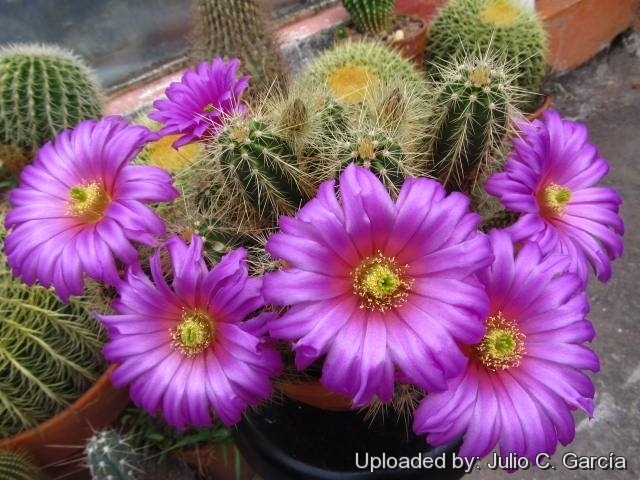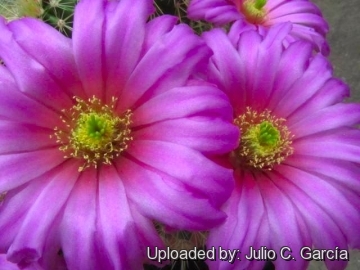
Echinocereus viereckii subs. huastecensis Photo by: Julio C. García
Origin and Habitat: Echinocereus viereckiiSN|21819]]SN|21819]] subs. huastecensis occurs only in Rayones Canyon, Nuevo León, Northeast Mexico.
Type Locality: Cañon de Rayones, 15km W of Hwy Fed. 85 on Hwy N.L. 6, 550m
Synonyms:
See all synonyms of Echinocereus viereckii
Description: Echinocereus viereckiiSN|21819]]SN|21819]] subs. huastecensis is a morphological or local form of the variable Echinocereus viereckiiSN|21819]]SN|21819]] distinguishes for its very long spines (up to 10 cm). It is a particularly beautiful plant in flower. The bloom is about 12 cm diameter.
Habit: It is a clustering cactus specie branching profusely from the base, ultimately forming somewhat open clumps up to 30 cm tall which can spread out as large as 1 m in size.
Stems: 30-60 cm long, 3-7.5 cm in diameter, soft , cylindrical ± tapering toward the tips initially upright then spreading to sprawling yellowish-green to bright green that will hold purple colour with enough bright light, During the winter rest they become wrinkled and flabby from lack of water and shrink up about 1/3 their size as they consume their stored water. With regular water they plump up quickly.
Ribs: 8-13 tuberculate.
Spines: Very short, yellowish up to 10 cm long.
Flowers: Magnificent magenta from the sides of the stems, short-funnellform, very large up to 10-12 cm in diameter or more. The flowers on all subspecies are Bright magenta.
Blooming season: Blossoms in May.
Fruit: Globose, green, fleshy.
Subspecies, varieties, forms and cultivars of plants belonging to the Echinocereus viereckii group
Bibliography: Major references and further lectures
1) Guadalupe Martínez, J. 2013. Echinocereus viereckii. The IUCN Red List of Threatened Species. Version 2014.3. <www.iucnredlist.org>. Downloaded on 28 November 2014.
2) Edward F. Anderson "The Cactus Family." Timber Press, Portland (Oregon) 2001
3) Curt Backeberg, Frederik Marcus Knuth: “Kaktus-ABC. En haandbog for fagfolk og amatører.” Kopenhagen 1936
4) Ulises Guzmán, Salvador Arias, Patricia Dávila “Catálogo de cactáceas mexicanas.” Universidad Nacional Autónoma de México, Mexiko-Stadt 2003
5) Werdermann: Kakteenkunde Organ der Deutschen Kakteen-Gesellschaft E.V., Berlin 1934, page. 188
6) Říha: Kaktusy (Brno). 11: 75 1974
7) W. Blum, M. Lange, W. Rischer, J. Rutow "Echinocereus" Preprint, 1998
8) James Cullen, Sabina G. Knees, H. Suzanne Cubey "The European Garden Flora Flowering Plants: A Manual for the Identification of Plants Cultivated in Europe, Both Out-of-Doors and Under Glass" Cambridge University Press, 11/Aug/2011
9) David R Hunt; Nigel P Taylor; Graham Charles; International Cactaceae Systematics Group. "The New Cactus Lexicon" dh books, 2006
 Echinocereus viereckii subs. huastecensis Photo by: Julio C. García
Echinocereus viereckii subs. huastecensis Photo by: Julio C. GarcíaSend a photo of this plant.The gallery now contains thousands of pictures, however it is possible to do even more. We are, of course, seeking photos of species not yet shown in the gallery but not only that, we are also looking for better pictures than those already present.
Read More... Cultivation and Propagation: This cactus is widely cultivated for its flowers, it is among the easiest species to grow, flower and propagate. Indicated for full sun exposure. Water regularly from March to October. Rot prone in winter, it needs good drainage, It should be kept in a cool place during winter rest (it can briefly tolerate temp. as low as -7°C). Without this cool winter period these plants normally won't get many buds. Clustering, great for a hanging display. Stems may possibly become purple and limp in winter, but revitalize in early spring.
Propagation: Seeds or cutting.











